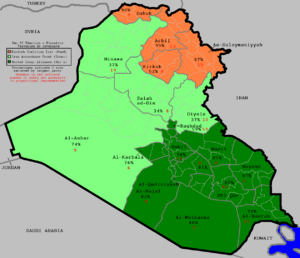Downing Reports: Brian M Downing and the world at war
Shortly before leaving his position atop the army high command, and after many years in Iraq, General Ray Odierno gave a candid and insightful presentation. He stated that it it might one day be necessary to place US personnel alongside Iraqi troops as they battle ISIL, and he took issue with GOP claims of the present administration’s handling of withdrawal from Iraq. He also offered that the ISIL War might be better waged if Iraq were to break into three states – Kurdistan in the north, Shia Iraq in the center and south, and Sunni Iraq in the west where Isilstan has been established but not yet defeated.
The importance of a Sunni autonomous or independent region has long been noted in discussions of the stability of post-Saddam Iraq and the conduct of the ISIL War. (See my August 2014 article “A Sunni Awakening in Iraq and the future of IS” and my March 2006 article “Salvaging Iraq, Three policies can help.”)
The American role in weakening Iraq
The Obama administration is committed to keeping Iraq a unitary country, comprising Sunnis, Shias, and Kurds. This may not be possible – or compatible with the objective of defeating ISIL. The US position is also paradoxical as American policies over the years have helped bring about the partial fragmentation of Iraq.
After the end of Gulf War One, the US and allied nations established an aircap over Kurdish Iraq. This prevented Saddam Hussein from regaining control and gave the Kurds de facto autonomy. With the destruction of the Iraqi army and state in Gulf War Two, Kurdistan took large step toward independence. The destruction of Sunni prominence, which dates back to British policies after 1918 and before that to those of the Ottomans, brought intense sectarian tensions. A political formula has proven elusive and mistrust flares into fighting. Iraq, as it was drawn up by European statesmen, scarcely existed.
ISIL
The sudden ascent of ISIL from shadowy bomb-makers to rulers of vast lands, stemmed from sectarian conflict. It also presents the problem of organizing Iraqi forces to fight it – and under what political framework.
The precursor of ISIL, the al Qaeda group that fought the US, was able to ensconce itself in Sunni regions, especially Anbar Province, from which it launched a series of terrorist bombings on Shia targets. The group grew and made common cause with remnants of Saddam’s officers, some of whom hold positions of authority in ISIL’s military and political wings. And last year, they swept into Syria and Iraq with alarming speed.
The Iraqi army and Kurdish peshmergas have had only limited success against ISIL.They will face even more formidable opposition as they push into Sunni areas where ISIL enjoys considerable support, if only as the army that drove out the Shias.
The best force to fight ISIL and reestablish control there will be Sunni tribal forces – the same fighters that fought the US, then allied with the US against foreign jihadis. The Sunnis, however, will not fight in numbers and in earnest unless they are granted autonomy from the Shias of Baghdad. That is the political-military formula to defeat ISIL in Iraq. That is what General Odierno meant by noting the need for Iraq to break up in order to better wage the ISIL War.
Western Iraq is already detached from Iraq and Baghdad cannot reassert control. The question now is, who will govern it. It’s between ISIL and indigenous Sunnis – between ISILstan and Sunnistan.
Further benefits – and problems
The Iraqi army is plagued by corruption and nepotism. It is also plagued by the government’s clinging to the fiction of a nation comprising Shias, Sunnis, and Kurds, and by its attempt to use the army as a means of unifying the country or suppressing opponents. This is unlikely. Sunnis resent serving under Shia officers and NCOs, Shias prize the turning of the sectarian tables, and Kurds prefer to serve with their own to the north. The Iraqi army would be more effective if it were a Shia force, as are the more effective Shia militias. The Sunnis and Kurds, through their desertions, are pushing the military in this direction anyway.
Granting Sunni autonomy or independence from Baghdad would help in the ISIL war in both Iraq and Syria. The largest Sunni confederation in Iraq, the Dulayim, stretch across western Iraq and into Syria. Properly armed and motivated, the Dulayim can attack ISIL positions and convoys, from the approaches to Baghdad all the way to Reqaa in eastern Syria.
A partitioned Iraq would help in building democracy there. Consensus in Baghdad would be more realizable without the sectarian and ethnic concerns of the fictive, vanishing country mapped out by Sykes and Picot amid the Great War. Democracy may not gain a purchase in the area, but it has a better chance with more homogeneous populations instead of trying to bind together people who mistrust, despise, and even massacre each other.
A Sunni autonomous or independent region would be an object of contention by Iran and Saudi Arabia. The former will see it as a threat to the lines of communication stretching to Shia allies in Lebanon and Syria; the latter will make every effort to see that the Sunni region becomes precisely that – a significant barrier to international Shia unity. Because “Sunnistan” will be poor and reliant on foreign support, alignment with the Saudis and other Sunni monarchies may be unavoidable. Subsidies from Baghdad and Tehran will seek to keep Sunnistan neutral, nonetheless, drift toward sectarian benefactors will be difficult to forestall.
Accordingly, breaking up Iraq may help in the ISIL War, but set the stage for fiercer sectarian rivalry. That’s the Middle East, that’s foreign policy.
©2015 Brian M Downing
